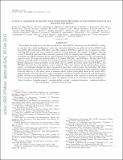P-MaNGA : gradients in recent star formation histories as diagnostics for galaxy growth and death
Abstract
We present an analysis of the data produced by the MaNGA prototype run (P-MaNGA), aiming to test how the radial gradients in recent star formation histories, as indicated by the 4000AA-break (D4000), Hdelta absorption (EW(Hd_A)) and Halpha emission (EW(Ha)) indices, can be useful for understanding disk growth and star formation cessation in local galaxies. We classify 12 galaxies observed on two P-MaNGA plates as either centrally quiescent (CQ) or centrally star-forming (CSF), according to whether D4000 measured in the central spaxel of each datacube exceeds 1.6. For each galaxy we generate both 2D maps and radial profiles of D4000, EW(Hd_A) and EW(Ha). We find that CSF galaxies generally show very weak or no radial variation in these diagnostics. In contrast, CQ galaxies present significant radial gradients, in the sense that D4000 decreases, while both EW(Hd_A) and EW(Ha) increase from the galactic center outward. The outer regions of the galaxies show greater scatter on diagrams relating the three parameters than their central parts. In particular, the clear separation between centrally-measured quiescent and star-forming galaxies in these diagnostic planes is largely filled in by the outer parts of galaxies whose global colors place them in the green valley, supporting the idea that the green valley represents a transition between blue-cloud and red-sequence phases, at least in our small sample. These results are consistent with a picture in which the cessation of star formation propagates from the center of a galaxy outwards as it moves to the red sequence.
Citation
Li , C , Wang , E , Lin , L , Bershady , M A , Bundy , K , Tremonti , C A , Xiao , T , Yan , R , Bizyaev , D , Blanton , M , Cales , S , Cherinka , B , Cheung , E , Drory , N , Emsellem , E , Fu , H , Gelfand , J , Law , D R , Lin , L , MacDonald , N , Maraston , C , Masters , K L , Merrifield , M R , Pan , K , Sanchez , S F , Schneider , D P , Thomas , D , Wake , D , Wang , L , Weijmans , A-M , Wilkinson , D , Yoachim , P , Zhang , K & Zheng , T 2015 , ' P-MaNGA : gradients in recent star formation histories as diagnostics for galaxy growth and death ' , Astrophysical Journal , vol. 804 , no. 2 . https://doi.org/10.1088/0004-637X/804/2/125
Publication
Astrophysical Journal
Status
Peer reviewed
ISSN
0004-637XType
Journal article
Description
C.L. acknowledges the support of the 100 Talents Program of Chinese Academy of Sciences (CAS). This work is supported by NSFC (11173045, 11233005, 11325314, 11320101002), by the Strategic Priority Research Program "The Emergence of Cosmological Structures" of CAS (grant No. XDB09000000), and by World Premier International Research Center Initiative (WPI Initiative), MEXT, Japan. We have made use of data from HyperLeda for our work. Funding for SDSS-III and SDSS-IV has been provided by the Alfred P. Sloan Foundation and Participating Institutions. Additional funding for SDSS-III comes from the National Science Foundation and the U.S. Department of Energy Office of Science.Collections
Items in the St Andrews Research Repository are protected by copyright, with all rights reserved, unless otherwise indicated.
Related items
Showing items related by title, author, creator and subject.
-
SDSS-IV MaNGA: How the stellar populations of passive central galaxies depend on stellar and halo mass
Oyarzún, Grecco A.; Bundy, Kevin; Westfall, Kyle B.; Tinker, Jeremy L.; Belfiore, Francesco; Argudo-Fernández, Maria; Zheng, Zheng; Conroy, Charlie; Masters, Karen L.; Wake, David; Law, David R.; McDermid, Richard M.; Aragón-Salamanca, Alfonso; Parikh, Taniya; Yan, Renbin; Bershady, Matthew; Sánchez, Sebastián F.; Andrews, Brett H.; Fernández-Trincado, José G.; Lane, Richard R.; Bizyaev, D.; Boardman, Nicholas Fraser; Lacerna, Ivan; Brownstein, J. R.; Drory, Niv; Zhang, Kai (2022-07-06) - Journal articleWe analyze spatially resolved and co-added SDSS-IV MaNGA spectra with signal-to-noise ratio ∼100 from 2200 passive central galaxies (z ∼ 0.05) to understand how central galaxy assembly depends on stellar mass (M*) and halo ... -
Secular-and merger-built bulges in barred galaxies
Mendez Abreu, Jairo; Debattista, V. P.; Corsini, E. M.; Aguerri, J. A. L. (2014-12) - Journal articleContext. Historically, galaxy bulges were thought to be single-component objects at the center of galaxies. However, this picture is now questioned since different bulge types with different formation paths, namely classical ... -
Galaxy And Mass Assembly (GAMA) : galaxy close pairs, mergers and the future fate of stellar mass
Robotham, A. S. G.; Driver, S. P.; Davies, L. J. M.; Hopkins, A. M.; Baldry, I. K.; Agius, N. K.; Bauer, A. E.; Bland-Hawthorn, J.; Brough, S.; Brown, M. J. I.; Cluver, M.; De Propris, R.; Drinkwater, M. J.; Holwerda, B. W.; Kelvin, L. S.; Lara-Lopez, M. A.; Liske, J.; Lopez-Sanchez, A. R.; Loveday, J.; Mahajan, S.; McNaught-Roberts, T.; Moffett, A.; Norberg, P.; Obreschkow, D.; Owers, M. S.; Penny, S. J.; Pimbblet, K.; Prescott, M.; Taylor, E. N.; van Kampen, E.; Wilkins, S. M. (2014-11-11) - Journal articleWe use a highly complete subset of the Galaxy And Mass Assembly II (GAMA-II) redshift sample to fully describe the stellar mass dependence of close pairs and mergers between 10(8) and 10(12)M(circle dot). Using the analytic ...

